News
A decrepit, smelly zoo holds underfed animals in appalling conditions
View(s):By Kasun Warakapitiya
Visitors to the Dehiwala zoo are far from happy by the management of the zoo and the treatment of its animals.
They said that the zoo, which was celebrating its 88th anniversary, was not maintained properly, and visitor interest had declined. They feel the animals are neglected and have little freedom of movement.
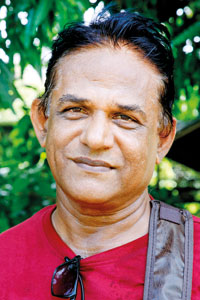
Sampath Pigera
Visitors are unsatisfied as they feel the entry fee has not benefited the animals, as the animals appear malnourished and live in unhygienic conditions. There was food scattered about in the aviaries. Mice, too were seen in the aviaries, feeding and drinking the food and water left for the birds. Visitors were put off by the stench of animal excrement.
The Sunday Times went undercover on July 2 to observe the animals’ condition and the experience that visitors go through.
The reception at the ticketing booths, too, was not welcoming, as the cashier at the ticketing counter kept on yelling that there was no change and refused to give change to visitors.
Notices outside the ticket counter display prices of Rs. 118 for children, Rs. 295 for adults, and Rs. 59 for students, but the tickets issued to adults have Rs. 250 printed on them.
In the aquarium, there is no lighting in the first section, forcing visitors to walk in darkness. The pond, which mimicked a slow-moving stream, was not visible due to a lack of lighting.
Some tanks that were off display remained dark, while the glass of one tank was covered in newspaper.
An Arapaima, the largest freshwater fish, which grows over 10 feet (3 metres), is in a tank that is too small for its size. The tank is only a few feet longer than the fish, and the width matches its length. It is the only specimen in the tank.
Visitors felt pity for the large fish.
H.M.N. Manike, 58, a from Galle, said, “Look at this fish; it swims all alone; the tank is too small.’’
The coral appeared dead in the marine exhibits.
The pen housing two ostriches remained bare with sand, while the two birds kept pecking on the railings of the enclosure. They had shed some of their plumage.
An elderly visitor from Polonnaruwa, I.P. Jayaratne, 68, pointed out that if zoos make revenue out of animals, they should look into the animals’ welfare.
“The moat at the ostrich pen is bone dry; there is no food left outside for them. Zoo staff should treat animals better,’’ he said.
The butterfly enclosure has been under renovation for years and remains closed.
The visitors were saddened by the plight of a lonely Eurasian brown bear. It is thin, is shedding fur, and is seen gazing pitifully upward from its enclosure, which resembles a pit.

I.P.Jayaratne
“This animal is all alone in the concrete enclosure, which only has two patches of grass. It looks lonely, sad, and trapped. Apart from that, it looks old or sick,” Rathnayake Mudiyanselage Leelaratne, 57, said.
He said the brown bears seen in documentaries are fatter and more robust.
The Dehiwala zoo only has one sloth bear, and it was off display as it was unwell.
The Sunday Times observed that in many large animal enclosures, moats remained fully or half drained with a trickle of muddy water. This was seen in the enclosures of large animals such as lions, orangutans, chimpanzees, and baboons.
The orangutan makes hand gestures, seeking food from visitors. Despite warning signs, people toss human food in plastic wrapping into the enclosure.
In the chimpanzee enclosure, the tree is overgrown, and its branches are dangerously close to the edge of the enclosure. One chimp was seen scaling up the tree, fixing its gaze on a nearby tree outside the enclosure.
Some visitors were seen harassing the pigmy hippos by poking sticks into their gaping mouths. There were no employees to prevent such behaviour.
Visitors also expressed concern over the isolation of certain animals. The two zebras are housed separately. The camel had an injury to its hump, and the giraffe was alone. There were three giraffes previously.
The deer, sambar, and antelope areas are bare. There is no grass, and the deer had eaten jack tree branches given to them and were seen stripping the twigs, which had no leaves. The sambar are shedding their coats, and there are injuries on their backs.
Some youth were also unhappy over the condition of the animals.
Thisaru Adithya Peterson, who was visiting with a friend, said the experience was appalling.
He said the zoo should educate the public on wild animals by offering a pleasant experience; instead, they see animals who appear to be suffering.

Sad sight: Biggest fresh water fish in a tank too small for its size. Pix by M.A. Pushpa Kumara
“One of the baboons has huge growth in its rear area; the lions were lethargic like they were not fed properly. This needs to change. We don’t need more animals; we need the zoo authority to take care of the animals we have,’’ Mr. Peterson said.
In the spider monkey enclosure, the wooden poles have collapsed, and the rope that allowed the monkey to move around has snapped.
The reptilium also has one enclosure with cracked glass, housing a python.
The tank at the pelican feeding area had not been cleaned for some time, and invasive water plants had spread. Brooms and discarded plastic bottles were found in the water tank as well. The waterfall area pond, too, needed to be cleaned, as the water appeared to stagnate.
Sampath Pigera, 59, a pastor from Wattala, said the zoo’s condition has worsened over the years. There are fewer animals, some of which are the only specimens in the cages.
“The zoo should treat the animals better to attract more visitors,” he said.
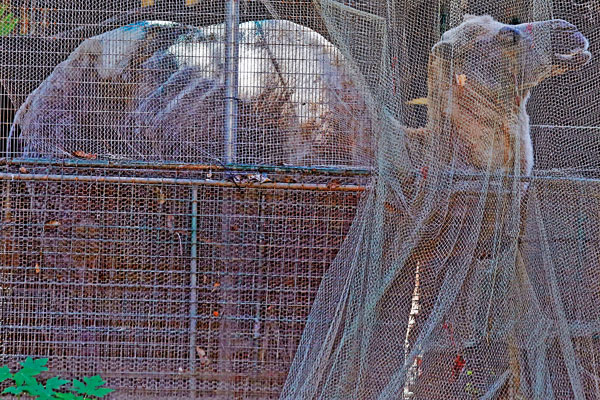
The camel with an injured hump
Meanwhile National Zoological Gardens Director General, Ranjan Marasinghe, said displaying animals to the public is not the only task of the zoo. The conservation of rare animals is the main goal. Breeding rare local animals and rewilding them are priorities.
He did not completely deny the allegations and admitted that there were areas where the zoo needs to be improved, along with recruiting more staff.
According to him, the brown bear at the zoo is 36 years old and is one of the oldest bears in captivity.
“The eldest bear in captivity was 37 years old. If our bear passes that age, it will be a record. The animal is old; there is no cure for that. We give him good care, but it is thin due to its age.”
He said the bear cannot be paired with another as it does not have reproductive capabilities at its present age and “a younger specimen could harm it, given its state,’’
Zebras and giraffes are to be added to the zoo.
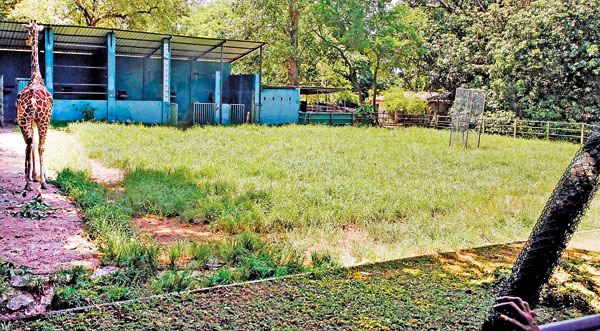
A solitary giraff in its enclosure
Mr. Marasinghe admitted that shortages of change at the cashier have been a long-standing issue. However, credit and debit cards are accepted. E-tickets are also being issued from July 3. (See box)
He added that the zoo originally charged Rs 250 from an adult; however, due to the VAT, the price has risen to Rs 295.
“The sloth bear is alone, as it is a native species. The only way we could get more animals is through the Department of Wildlife Conservation. When we tried to obtain bears back in the day, animal rights activists staged a protest and stopped our effort, condemning our animal to live alone,” he said.
He said people with vested interests were trying to tarnish the good name of the zoo by making false allegations. He claimed animals are fed, housed, and cared for according to veterinary advice based on scientific methods.
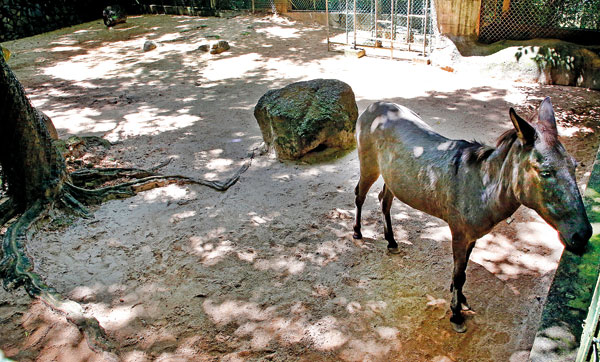
No company: The mule
| Entrance tickets to go online The zoo’s 88th anniversary was celebrated on Wednesday, with a piece of cake being fed to a lion cub. Even the zoo’s oldest animal resident, the giant tortoise, was brought to the event. The zoo also announced a pilot project for an electronic ticketing system. Director General Ranjan Marasinghe said it will enable visitors to pre-plan and book from home. This will also prevent queues from forming at the gates. “This will be first implemented in Dehiwala Zoo and planned to be later expanded to other zoos according to its success.’’ He said all state zoos accept credit and debit cards. The e-tickets can be obtained via the link https://tickets.nationalzoo.gov.lk/. | |
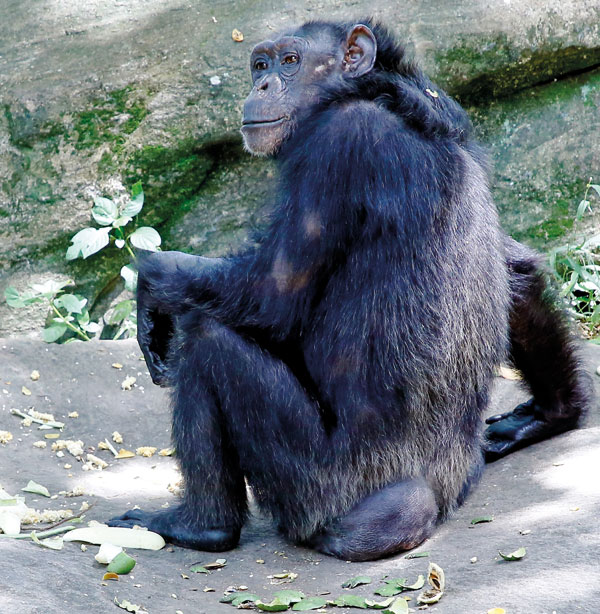
A sad looking chimpanzee
The best way to say that you found the home of your dreams is by finding it on Hitad.lk. We have listings for apartments for sale or rent in Sri Lanka, no matter what locale you're looking for! Whether you live in Colombo, Galle, Kandy, Matara, Jaffna and more - we've got them all!

